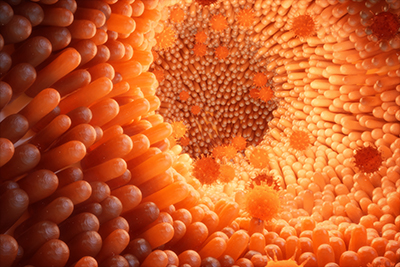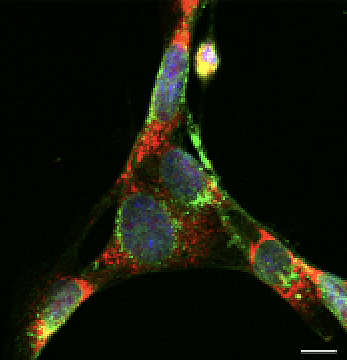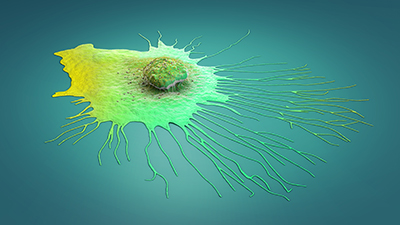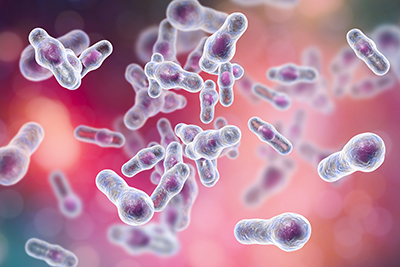Discoveries
-

Study explores the role of MYCN in Triple Negative Breast Cancer diagnosis and treatment
By Mary Alice Keller Triple-negative breast cancer is a type of breast cancer that tests negative for the three receptors that are commonly found in breast cancer: estrogen receptors, progesterone receptors, and human epidermal growth factor receptor 2 (HER2) receptors. The oncogene MYCN regulates cancer cell growth, proliferation, metabolism, and… Read MoreSep. 10, 2020
-

Vip1 allows cells to adapt to changing conditions
By Francisco Rodriguez Cells detect the nutrients that are in their environment and can adapt depending on what they sense. The class of signaling molecules known as inositol diphosphates or PP-IPs affects cellular shape, nutrient sensing and many other biological processes among organisms as simple as yeast and… Read MoreAug. 28, 2020
-

Non-neutralizing antibodies from a Marburg infection survivor show therapeutic potential
By Sohini Roy The WHO reports that the Marburg virus has an average fatality rate of 50 percent, but fatality rate can be of up to 88 percent depending on the strain and the outbreak. Marburg viruses cause a hemorrhagic fever in humans, with a fatality rate of up to… Read MoreAug. 28, 2020
-

A potential new targeted therapy for metastatic melanoma
By Wendy Bindeman https://cdn.vanderbilt.edu/t2-main/medschool-prd/wp-content/uploads/sites/101/2020/08/Discovery_Richmond-SMWeb-1.mp4 Melanoma is the most common of all cancers. The American Cancer Society estimates that over 100,000 new melanomas will be diagnosed in the U.S. in 2020. While 60 percent of people with metastatic melanoma, an aggressive type of skin cancer, have multiple treatment options… Read MoreAug. 19, 2020
-

STING pathway stimulation promotes survival in preclinical models of neuroblastoma
By Sohini Roy Neuro-2a cells after treatment with STING-NP. (Wang-Bishop et al. Journal for ImmunoTherapy of Cancer, through a CC BY-NC 4.0 license) Neuroblastoma, an aggressive pediatric brain cancer with a high mortality rate, boasts a unique microenvironment that puts the brakes on infiltrating… Read MoreJul. 14, 2020
-

A cell’s breadcrumb trail: Exosomes mediate cell migration
https://cdn.vanderbilt.edu/t2-main/medschool-prd/wp-content/uploads/sites/101/2020/07/Discovery_Weaver-SM-Web-1.mp4 By Sarah Glass Cells use exosomes as pathfinding tools during migration-related processes, such as embryonic development, wound healing, and cancer metastasis. © Christoph Burgstedt, stock.adobe.com Scientists once dismissed the small, membrane-bound particles packed with proteins, nucleic acids, and lipids that are expelled by cells as mere cellular… Read MoreJul. 12, 2020
-

Cellular stress regulates β-cell dysfunction in type 2 diabetes
By Heather Caslin Approximately 30 million Americans have type 2 diabetes. The majority are over 45 years old. © Vitalii Vodolazskyi, stock.adobe.com Within the pancreas, β-cells produce insulin that delivers energy to tissues through glucose. People with type 2 diabetes have smaller, less functional β-cells; however, the mechanisms that drive… Read MoreJun. 26, 2020
-

Regulating protein synthesis genes
https://cdn.vanderbilt.edu/t2-main/medschool-prd/wp-content/uploads/sites/101/2020/05/Tansey_website.mp4 By Suneethi Sivakumaran WDR5 has different moonlighting roles in the body, including in chromatin regulation and in chromatin-independent processes such as cell division. © Ian Dyball, stock.adobe.com The human body is a complicated network of interdependent cellular processes regulated by gene-encoded proteins. Proteins… Read MoreMay. 6, 2020
-

Preventing CDI deaths one stem cell at a time
https://cdn.vanderbilt.edu/t2-main/medschool-prd/wp-content/uploads/sites/101/2020/04/Lacy_Website.mp4 By Sara Eaton C. diff is responsible for 50% of gastrointestinal infections in hospitals but cause over 90% of GI tract infection-related deaths. © Kateryna_Kon, stock.adobe.com Gastrointestinal infections often cause damage to the stem cells in the colon’s epithelium, a thin layer of… Read MoreApr. 23, 2020
-

An ounce of prevention is worth two pounds of cure
https://cdn.vanderbilt.edu/t2-main/medschool-prd/wp-content/uploads/sites/101/2020/04/Goldenring_Website-1.mp4 By Sarah Glass Gastric cancer is one of the leading causes of cancer death in the U.S. © Crystal light, stock.adobe.com Clocking in at two pounds, the stomach is one of the body’s heaviest internal organs and can become afflicted with one of the leading causes of… Read MoreApr. 10, 2020